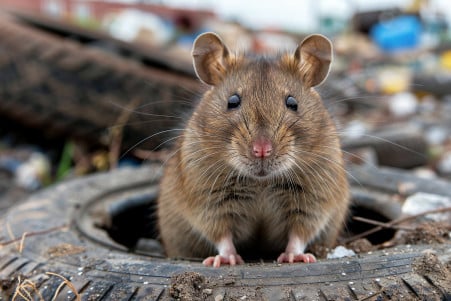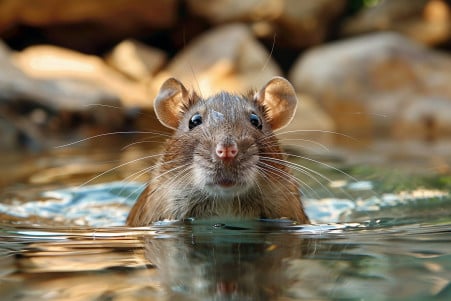How Big Do Rats Get? A Look at the Largest Rat Species
5 June 2024 • Updated 5 June 2024

Rats can be as small as a mouse or as large as a small dog, depending on the species and other factors. In general, the largest species of rat, such as the Gambian pouched rat, can grow to be over 3 feet long and weigh more than 3 pounds. Pet fancy rats, on the other hand, usually weigh between 1 and 2 pounds, and wild brown rats in cities are often no more than 1 pound.
This article will take a deep dive into scientific research from a variety of fields to explain the factors that determine the size and growth of rats. This synthesis will draw on research in genetics, ecology, evolutionary biology, and animal husbandry. Along the way, you will learn about the amazing diversity of the rat family and the factors that lead to the largest rats in the world.
How big can rats get?
The True Giants: The World's Largest Rat Species
The Bosavi woolly rat, which hails from Papua New Guinea, is a true giant among rodents. As CNN explains, this newly discovered species can grow to a whopping 32 inches in length and weigh up to 3.3 pounds, making it one of the largest rats ever discovered. Yet even the Bosavi woolly rat is dwarfed by an extinct rodent whose bones, found in a cave according to Live Science, suggest it weighed a massive 13.2 pounds.
While these are the true giants, there are also several other species that vie for the title of the world's largest living rat. The Gambian pouched rat from Africa can grow to 3 feet long and 3 pounds, while the Northern Luzon Cloud Rat from the Philippines has been recorded at 2.5 feet and 5.7 pounds. The Sumatran Bamboo Rat is also a large species, with the biggest individual weighing in at almost 9 pounds. These animals live in the wild in Africa, Asia and the Pacific, and their size is an adaptation that allows them to survive in the specific environments and ecological niches they occupy.
Genetic, Environmental, and Evolutionary Determinants of Rat Size
Rat size is determined by a complex interplay of genetic and environmental factors. A study in the Journal of Interdisciplinary Cycle Research showed that the genetic component of variance increased significantly up to 80 days of age, while the maternal component of variance was high in the early stage of postnatal growth and decreased with time. This indicates that genetic factors have a greater impact as rats grow older, while maternal factors have a smaller impact as rats grow older.
Meanwhile, a study in the Journal of Craniofacial Genetics and Developmental Biology showed that environmental factors, including vegetation productivity and resource availability, also affect body size. This is consistent with the "resource availability hypothesis," which suggests that rodent size is more closely related to precipitation-related climatic factors than latitude/temperature.
Evolutionary adaptations have also led to larger sizes in certain rat species to better suit their ecological niches. A study in Global Ecology and Biogeography showed that body size in rodents is primarily driven by variation in vegetation productivity, which in turn limits species range size. Knowledge of these genetic, environmental, and evolutionary determinants is important for predicting the potential maximum sizes and extinction risks of rat species.
Threats and Risks to Large Rat Species
Many of the large rat species are at risk due to human impacts such as habitat destruction and invasive species. Defenders of Wildlife reports that the giant kangaroo rat in California has experienced population declines due to energy development, housing, and agriculture.
Invasive rat species, including the Pacific rat, black rat, and brown rat, are one of the greatest threats to native wildlife worldwide. A blog post on invasive species explains that these rats can outcompete native species for food and other resources, spread diseases, and cause extinctions, especially on islands. They are even ranked as the second most damaging invasive species in the world, just behind humans.
It is important to focus on conservation to ensure the survival of these important and special rat species. If nothing is done, the impact of human expansion and the spread of invasive rats could lead to the extinction of some of the largest rodents on Earth.
Health Risks and Pest Control: How to Deal With Large Rat Infestations
Large rat species can transmit serious illnesses such as hantavirus, leptospirosis, and rat bite fever through their urine, feces, and saliva. The Wisconsin Department of Health Services notes that these diseases can be spread through direct contact with contaminated materials or by breathing in aerosolized droplets. When dealing with rat infestations, it’s important to take the proper precautions, including wearing protective clothing and using disinfectants.
The most successful pest control methods for large rats include a mix of sanitation, exclusion, trapping, and the careful use of rodenticides. Insight Pest Management notes that professional services are the best way to ensure long-term control because they can help eliminate infestations and reduce health risks. However, the Occupational Safety and Health Administration warns that rodenticides can be toxic to animals that eat rats, so it’s best to use alternative methods like integrated pest management.
To avoid large rat infestations and the health risks that come with them, it’s important to catch the problem early and take action quickly. The University of Missouri Extension explains that it’s important to take a comprehensive approach that targets the rats’ food, shelter, and breeding opportunities to successfully control these adaptable pests.
Rats in Culture: Symbolism, Folklore, and Artistic Representations
Rats have been symbolic in a variety of ways in different cultures and traditions throughout history. According to Hammer Tech Ltd., in many mythologies, rats are considered to be trickster gods or divine messengers and are associated with wealth, fertility, and resourcefulness. The Pied Piper of Hamelin folktale is a classic example of rats being used to symbolize the mysterious and even sinister aspects of the divine.
Rats are also common symbols in dreams, where they often represent repressed emotions, control, or a lack of confidence. In literature and art, rats have been used to symbolize the other and darker side of human nature, as well as themes of survival and redemption, as discussed in Literary Hub's article. Rat tattoos and other cultural depictions of rats are a reflection of the many symbolic meanings that have been attached to these resilient animals.
Whether they are revered as sacred animals or reviled as disease-carrying vermin, the rat's place in human culture is a rich and varied one. This diversity of symbolism is a testament to the rat family's adaptability and success.
Conclusion: The Wide Range of Rat Sizes
Rats are an incredibly diverse group of animals in terms of size, with some pet rats weighing just a few ounces and the largest wild rats weighing several pounds. The biggest rat species live in remote regions and have evolved to fill specific ecological niches. Genetic, environmental, and evolutionary factors all contribute to the maximum size potential of different rat species.
While some giant rat species are threatened by human activities, others have become invasive pests in certain areas. Understanding the diversity of rat sizes is important for conservation, pest control, and appreciating the biological diversity of the rat family.


